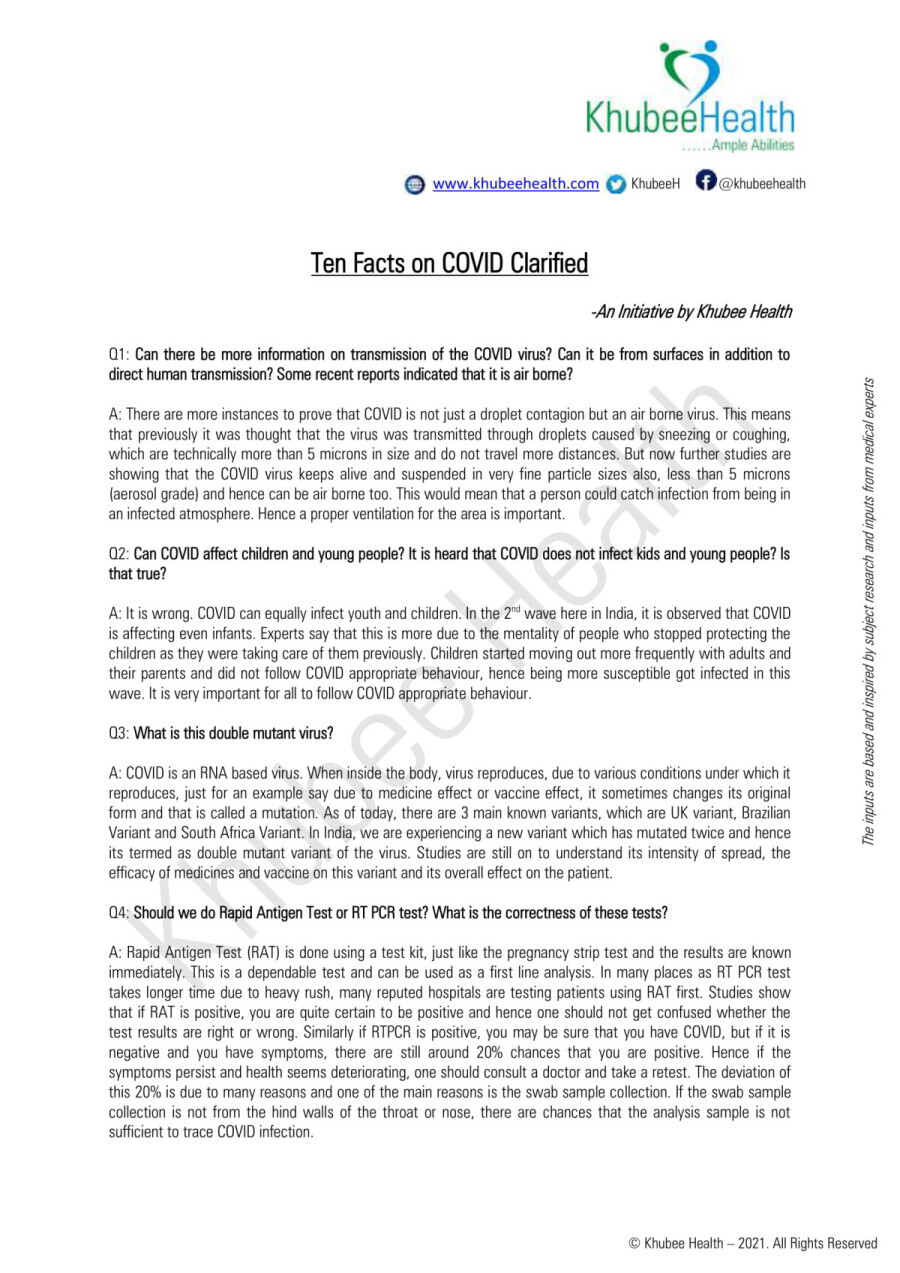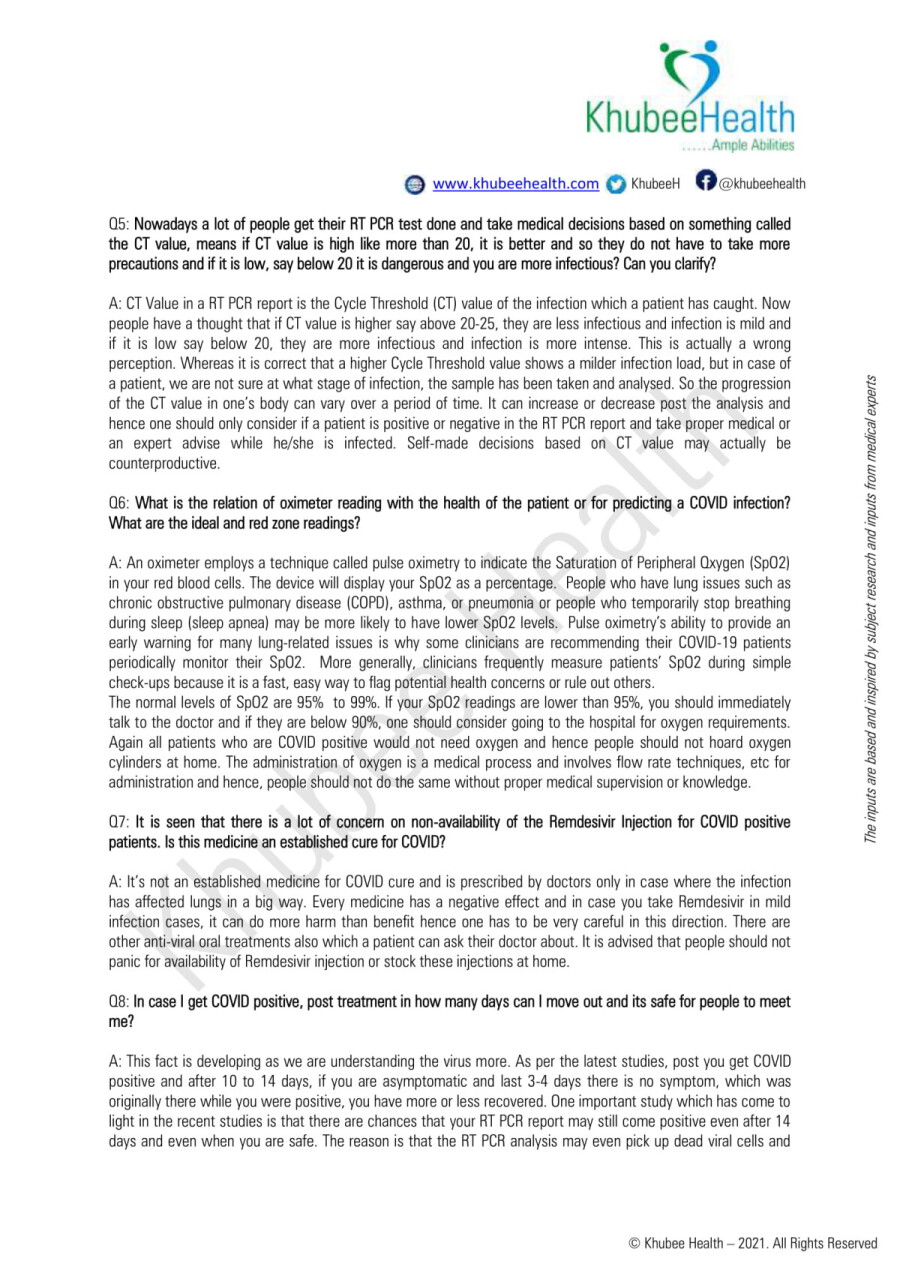Ten Facts on COVID Clarified
-An Initiative by Khubee Health
Q1: Can there be more information on transmission of the COVID virus? Can it be from surfaces in addition to direct human transmission? Some recent reports indicated that it is air borne?
A: There are more instances to prove that COVID is not just a droplet contagion but an air borne virus. This means that previously it was thought that the virus was transmitted through droplets caused by sneezing or coughing, which are technically more than 5 microns in size and do not travel more distances. But now further studies are showing that the COVID virus keeps alive and suspended in very fine particle sizes also, less than 5 microns (aerosol grade) and hence can be air borne too. This would mean that a person could catch infection from being in an infected atmosphere. Hence a proper ventilation for the area is important.
Q2: Can COVID affect children and young people? It is heard that COVID does not infect kids and young people? Is that true?
A: It is wrong. COVID can equally infect youth and children. In the 2nd wave here in India, it is observed that COVID is affecting even infants. Experts say that this is more due to the mentality of people who stopped protecting the children as they were taking care of them previously. Children started moving out more frequently with adults and their parents and did not follow COVID appropriate behaviour, hence being more susceptible got infected in this wave. It is very important for all to follow COVID appropriate behaviour.
Q3: What is this double mutant virus?
A: COVID is an RNA based virus. When inside the body, virus reproduces, due to various conditions under which it reproduces, just for an example say due to medicine effect or vaccine effect, it sometimes changes its original form and that is called a mutation. As of today, there are 3 main known variants, which are UK variant, Brazilian Variant and South Africa Variant. In India, we are experiencing a new variant which has mutated twice and hence its termed as double mutant variant of the virus. Studies are still on to understand its intensity of spread, the efficacy of medicines and vaccine on this variant and its overall effect on the patient.
Q4: Should we do Rapid Antigen Test or RT PCR test? What is the correctness of these tests?
A: Rapid Antigen Test (RAT) is done using a test kit, just like the pregnancy strip test and the results are known immediately. This is a dependable test and can be used as a first line analysis. In many places as RT PCR test takes longer time due to heavy rush, many reputed hospitals are testing patients using RAT first. Studies show that if RAT is positive, you are quite certain to be positive and hence one should not get confused whether the test results are right or wrong. Similarly if RTPCR is positive, you may be sure that you have COVID, but if it is negative and you have symptoms, there are still around 20% chances that you are positive. Hence if the symptoms persist and health seems deteriorating, one should consult a doctor and take a retest. The deviation of this 20% is due to many reasons and one of the main reasons is the swab sample collection. If the swab sample collection is not from the hind walls of the throat or nose, there are chances that the analysis sample is not sufficient to trace COVID infection.
Q5: Nowadays a lot of people get their RT PCR test done and take medical decisions based on something called the CT value, means if CT value is high like more than 20, it is better and so they do not have to take more precautions and if it is low, say below 20 it is dangerous and you are more infectious? Can you clarify?
A: CT Value in a RT PCR report is the Cycle Threshold (CT) value of the infection which a patient has caught. Now people have a thought that if CT value is higher say above 20-25, they are less infectious and infection is mild and if it is low say below 20, they are more infectious and infection is more intense. This is actually a wrong perception. Whereas it is correct that a higher Cycle Threshold value shows a milder infection load, but in case of a patient, we are not sure at what stage of infection, the sample has been taken and analysed. So the progression of the CT value in one’s body can vary over a period of time. It can increase or decrease post the analysis and hence one should only consider if a patient is positive or negative in the RT PCR report and take proper medical or an expert advise while he/she is infected. Self-made decisions based on CT value may actually be counterproductive.
Q6: What is the relation of oximeter reading with the health of the patient or for predicting a COVID infection? What are the ideal and red zone readings?
A: An oximeter employs a technique called pulse oximetry to indicate the Saturation of Peripheral Qxygen (SpO2) in your red blood cells. The device will display your SpO2 as a percentage. People who have lung issues such as chronic obstructive pulmonary disease (COPD), asthma, or pneumonia or people who temporarily stop breathing during sleep (sleep apnea) may be more likely to have lower SpO2 levels. Pulse oximetry’s ability to provide an early warning for many lung-related issues is why some clinicians are recommending their COVID-19 patients periodically monitor their SpO2. More generally, clinicians frequently measure patients’ SpO2 during simple check-ups because it is a fast, easy way to flag potential health concerns or rule out others.
The normal levels of SpO2 are 95% to 99%. If your SpO2 readings are lower than 95%, you should immediately talk to the doctor and if they are below 90%, one should consider going to the hospital for oxygen requirements. Again all patients who are COVID positive would not need oxygen and hence people should not hoard oxygen cylinders at home. The administration of oxygen is a medical process and involves flow rate techniques, etc for administration and hence, people should not do the same without proper medical supervision or knowledge.
Q7: It is seen that there is a lot of concern on non-availability of the Remdesivir Injection for COVID positive patients. Is this medicine an established cure for COVID?
A: It’s not an established medicine for COVID cure and is prescribed by doctors only in case where the infection has affected lungs in a big way. Every medicine has a negative effect and in case you take Remdesivir in mild infection cases, it can do more harm than benefit hence one has to be very careful in this direction. There are other anti-viral oral treatments also which a patient can ask their doctor about. It is advised that people should not panic for availability of Remdesivir injection or stock these injections at home.
Q8: In case I get COVID positive, post treatment in how many days can I move out and its safe for people to meet me?
A: This fact is developing as we are understanding the virus more. As per the latest studies, post you get COVID positive and after 10 to 14 days, if you are asymptomatic and last 3-4 days there is no symptom, which was originally there while you were positive, you have more or less recovered. One important study which has come to light in the recent studies is that there are chances that your RT PCR report may still come positive even after 14 days and even when you are safe. The reason is that the RT PCR analysis may even pick up dead viral cells and show a positive result. But as per the health experts, post 10-14 days of being COVID positive, if you are asymptomatic, you can meet people but by following COVID appropriate behaviour.
Q9: It is seen that even after vaccination, in some cases while people have taken both doses, they are still getting affected. What is the fact? Is vaccination really effective? Can you clarify?
A: For this, one needs to understand the difference between an infection and disease. While you can be infected even after taking a vaccine, you will not have a severe disease. This means that post vaccination, your body will develop antibodies which will not let the virus create a disease in your body. You can still be infected with the COVID symptoms due to the virus in your throat and nose and it may multiply also for some time, but your respiratory system will most likely be protected from a severe disease and you will recover soon. So its good to be vaccinated.
Q10: If a person has taken 1st shot of COVID vaccine and he gets infected after 1st shot, does he have to take the vaccine again 2 times or how will it affect his vaccination plan?
A: As indicated before, a COVID vaccine creates antibodies in a person. The second shot is a booster dose which assists further development of antibodies in an individual. Now if someone has taken 1 shot and he gets COVID positive, the positive news is that as he recovers, his body develops further natural antibodies and his fighting mechanism against COVID gets more robust. As per the experts, in that context, he can actually delay his booster dose (2nd shot) by a couple of weeks without letting his immunity come down. Hence, there is no need to repeat the first shot in such a case.
Note: The inputs are based and inspired by subject research and inputs from medical experts
References:



